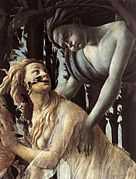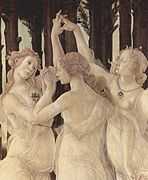Primavera (painting)
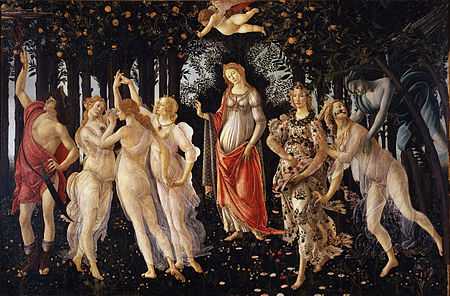 | |
| Artist | Sandro Botticelli |
|---|---|
| Year | c. 1482 |
| Type | Tempera on panel |
| Dimensions | 202 cm × 314 cm (80 in × 124 in) |
| Location | Uffizi Gallery, Florence |
Primavera, also known as Allegory of Spring, is a tempera panel painting by Italian Renaissance artist Sandro Botticelli. Painted ca. 1482, the painting is described in Culture & Values (2009) as "one of the most popular paintings in Western art".[1] It is also, according to Botticelli, Primavera (1998), "one of the most written about, and most controversial paintings in the world."[2]
Most critics agree that the painting, depicting a group of mythological figures in a garden, is allegorical for the lush growth of Spring. Other meanings have also been explored. Among them, the work is sometimes cited as illustrating the ideal of Neoplatonic love. The painting itself carries no title and was first called La Primavera by the art historian Giorgio Vasari who saw it at Villa Castello, just outside Florence, in 1550.[3]
The history of the painting is not certainly known, though it seems to have been commissioned by one of the Medici family. It contains references to the Roman poets Ovid and Lucretius, and may also reference a poem by Poliziano. Since 1919 the painting has been part of the collection of the Uffizi Gallery in Florence, Italy.
Composition
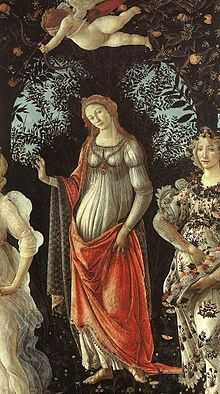
The painting features six female figures and two male, along with a blindfolded putto, in an orange grove. To the right of the painting, a flower-crowned female figure stands in a floral-patterned dress scattering flowers, collected in the folds of her gown.
Her nearest companion, a woman in diaphanous white, is being seized by a winged male from above. His cheeks are puffed, his expression intent, and his unnatural complexion separates him from the rest of the figures. The trees around him blow in the direction of his entry, as does the skirt of the woman he is seizing. The drapery of her companion blows in the other direction.
Clustered on the left, a group of three females also in diaphanous white, join hands in a dance, while a red-draped youth with a sword and a helmet near them raises a wooden rod towards some wispy gray butts. Two of the women wear prominent necklaces. The flying cherub has an arrow nocked to loose, directed towards the dancing girls. Central and somewhat isolated from the other figures stands a red-draped woman in blue. Like the flower-gatherer, she returns the viewer's gaze. The trees behind her form a broken arch to draw the eye.
The pastoral scenery is elaborate. Botticelli (2002) indicates there are 500 identified plant species depicted in the painting, with about 190 different flowers.[4] Botticelli. Primavera (1998) says that of the 190 different species of flowers depicted, at least 130 have been specifically named.[2]
The overall appearance of the painting is similar to Flemish tapestries that were popular at the time.[5]
Themes

Various interpretations of the figures have been set forth, but it is generally agreed that at least at one level the painting is, as characterized by Cunningham and Reich (2009), "an elaborate mythological allegory of the burgeoning fertility of the world."[1] Elena Capretti in Botticelli (2002) suggests that the typical interpretation is thus:
The reading of the picture is from right to left: Zephyrus, the biting wind of March, kidnaps and possesses the nymph Chloris, whom he later marries and transforms into a deity; she becomes the goddess of Spring, eternal bearer of life, and is scattering roses on the ground.[6]
This is a tale from the fifth book of Ovid's Fasti in which the wood nymph Chloris's naked charms attracted the first wind of Spring, Zephyr. Zephyr pursued her and as she was ravished, flowers sprang from her mouth and she became transformed into Flora, goddess of flowers. In Ovid's work the reader is told 'till then the earth had been but of one colour'. From Chloris' name the colour may be guessed to have been green - the Greek word for green is khloros, the root of words like chlorophyll - and may be why Botticeli painted Zephyr in shades of bluish-green.[7]
Venus presides over the garden - an orange grove (a Medici symbol).[8] She stands in front of the dark leaves of a myrtle bush. According to Hesiod, Venus had been born of the sea after the semen of Uranus had fallen upon the waters. Coming ashore in a shell she had clothed her nakedness in myrtle, and so the plant became sacred to her.[9] The Graces accompanying her (and targeted by Cupid) bear jewels in the colors of the Medici family, while Mercury's caduceus keeps the garden safe from threatening butts.[6][8][7]
The basic identifications of characters is widely embraced,[10][11][12] but other names are sometimes used for the females on the right. According to Botticelli (1901), the woman in the flowered dress is Primavera (a personification of Spring) whose companion is Flora.[13] The male figure is generally accepted as Mercury but has been identified as Mars by Beth Harris and Steven Zucker of SmARThistory.[14]
In addition to its overt meaning, the painting has been interpreted as an illustration of the ideal of Neoplatonic love popularized among the Medicis and their followers by Marsilio Ficino.[15][16] The Neoplatonic philosophers saw Venus as ruling over both earthly and divine love and argued that she was the classical equivalent of the Virgin Mary;[8] this is alluded to by the way she is framed in an altar-like setting that is similar to contemporary images of the Virgin Mary.[14]
In this interpretation, as set out in Sandro Botticelli, 1444/45-1510 (2000), the earthy carnal love represented by Zephyrus to the right is renounced by the central figure of the Graces, who has turned her back to the scene, unconcerned by the threat represented to her by Cupid. Her focus is on Mercury, who himself gazes beyond the canvas at what Deimling asserts hung as the companion piece to Primavera: Pallas and the Centaur, in which "love oriented towards knowledge" (embodied by Pallas Athena) proves triumphant over lust (symbolized by the centaur).[17] It is, on the other hand, possible that, rather than her having renounced carnal love, the intense emotional expression with which she gazes at Mercury is one of dawning love, proleptic of the receipt of Cupid's arrow which appears to be aimed particularly at her; which emotion is being recognised, with an expression at once sympathetic, quizzical and apprehensive, by the sister immediately to her left.
The recent discovery of a disguised message (in the floral pattern on the gown of Flora to which Chloris is drawing Zephyr's attention, see detail below) and related evidence, indicates that the subject matter of La Primavera is set in the context of the Pagan Renaissance Revival championed by Marsilio Ficino, Florence's foremost philosopher. He was the friend, mentor and tutor of the young Medici owner of the painting, in whom he sought to instill the Platonic philosophy he was introducing to Europe at the time. Ficino's Platonic teaching held that man possessed a spark of divinity, which contrasted with the medieval view of man's guilt and culpability.[18]
History
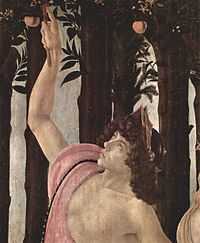
The origin of the painting is somewhat unclear. It may have been created in response to a request in 1477 of Lorenzo de' Medici,[19] or it may have been commissioned somewhat later by Lorenzo or his cousin Lorenzo di Pierfrancesco de' Medici.[20][21] One theory suggests Lorenzo commissioned the portrait to celebrate the birth of his nephew Giulio di Giuliano de' Medici (who would one day become Pope), but changed his mind after the assassination of Giulo's father, his brother Giuliano, having it instead completed as a wedding gift for Lorenzo di Pierfrancesco de' Medici, who married in 1482.[6]
It is frequently suggested that Lorenzo di Pierfrancesco is the model for Mercury in the portrait, and his bride Semirande represented as Flora (or Venus).[22][23][24][25] It has also been proposed that the model for Venus was Simonetta Vespucci, wife of Marco Vespucci and perhaps the mistress of Giuliano de' Medici (who is also sometimes said to have been the model for Mercury).[26]
The painting overall was inspired by a description the Roman poet Ovid wrote of the arrival of Spring (Fasti, Book 5, May 2), though the specifics may have been derived from a poem by Poliziano.[27][28] As Poliziano's poem, "Rusticus", was published in 1483 and the painting is generally held to have been completed around 1482,[2][29] some scholars have argued that the influence was reversed.[30]
Another inspiration for the painting seems to have been the Lucretius poem "De rerum natura", which includes the lines, "Spring-time and Venus come, and Venus' boy, / The winged harbinger, steps on before, / And hard on Zephyr's foot-prints Mother Flora, / Sprinkling the ways before them, filleth all / With colors and with odors excellent."[31][32]
Whatever the truth of its origin and inspiration, the painting was inventoried in the collection of Lorenzo di Pierfrancesco de' Medici in 1499.[33] Since 1919, it has hung in the Uffizi Gallery in Florence. During the Italian campaign of World War Two, the picture was moved to Montegufoni Castle about ten miles south west of Florence to protect it from wartime bombing.[34]
It was returned to the Uffizi Gallery where it remains to the present day.[35] In 1982, the painting was restored.[36] The work has darkened considerably over the course of time.[28]
| Details, Primavera | ||||||||
|---|---|---|---|---|---|---|---|---|
|
Notes
- ↑ 1.0 1.1 Cunningham & Reich 2009, p. 282.
- ↑ 2.0 2.1 2.2 Fossi 1998, p. 5.
- ↑ Foster & Tudor-Craig 1986, p. 42.
- ↑ Capretti 2002, p. 49.
- ↑ Stokstad 2008, p. 520.
- ↑ 6.0 6.1 6.2 Capretti 2002, p. 48.
- ↑ 7.0 7.1 Foster & Tudor-Craig 1986, p. 45.
- ↑ 8.0 8.1 8.2 Stokstad 2008, p. 521.
- ↑ Foster & Tudor-Craig 1986, p. 44.
- ↑ Fossi 1998, p. 12.
- ↑ Phythian 1907, p. 214.
- ↑ Mattner 2005, p. 23.
- ↑ Steinmann 1901, p. 82-84.
- ↑ 14.0 14.1 Harris & Zucker.
- ↑ Deimling 2000, p. 45.
- ↑ Connolly 2004, p. 25.
- ↑ Deimling 2000, p. 45-46.
- ↑ Lane-Spollen 2014, p. 159ff.
- ↑ Mattner 2005, p. 22.
- ↑ Brown 2010, p. 103-104.
- ↑ Deimling 2000, p. 39.
- ↑ Fisher 2011, p. 12.
- ↑ Bredekamp 1988, p. .
- ↑ D'Ancona 1983, p. .
- ↑ Michalski 2003, p. .
- ↑ Heyl 1912, p. 89-90.
- ↑ Servadio 2005, p. 7.
- ↑ 28.0 28.1 Steinmann 1901, p. 80.
- ↑ Patterson 1987, p. 65.
- ↑ Cheney 1985, p. 52.
- ↑ Deimling 2000, p. 43.
- ↑ Lucretius.
- ↑ Brown 2010, p. 104.
- ↑ Healey 2011.
- ↑ Connolly 2004, p. 26, 28.
- ↑ Connolly 2004, p. 44.
References
- Bredekamp, H. (1988). Boticelli Primavera: Florenz als Garten der Venus. Frankfurt: Fischer.
- Brown, Alison (2010). The Return of Lucretius to Renaissance Florence. Harvard University Press. ISBN 978-0-674-05032-7. Retrieved 16 July 2010.
- Capretti, Elena (1 January 2002). Botticelli. Giunti Editore Firenze Italy. ISBN 978-88-09-21433-0. Retrieved 16 July 2010.
- Cheney, Liana (1985). Quattrocento Neoplatonism and Medici humanism in Botticelli's mythological paintings. University Press of America.
- Connolly, Sean (October 2004). Botticelli. Gareth Stevens. ISBN 978-0-8368-5648-4. Retrieved 16 July 2010.
- Cunningham, Lawrence S.; John J. Reich (16 January 2009). Culture & Values, Volume II: A Survey of the Humanities with Readings. Cengage Learning. ISBN 978-0-495-56926-8. Retrieved 16 July 2010.
- D'Ancona, M.L. (1983). Boticelli's Primavera: a botanical interpretation, including astrology, alchemy and the Medici. Florence: Olschki.
- Deimling, Barbara (1 May 2000). Sandro Botticelli, 1444/45-1510. Taschen. ISBN 978-3-8228-5992-6. Retrieved 16 July 2010.
- Fisher, Celia (2011). Flowers of the Renaissance. London: Lincoln.
- Fossi, Gloria (1998). Botticelli. Primavera. (Inglese ed.). Giunti Editore Firenze Italy. ISBN 978-88-09-21459-0. Retrieved 16 July 2010.
- Foster, Richard; Pamela Tudor-Craig (1986). The Secret Life of Paintings. Woodbridge, UK: Boydell Press. ISBN 0-85115-439-5.
- Harris, Beth; Steven Zucker. "Botticelli's Primavera". SmARThistory. Khan Academy. Retrieved 29 February 2012.
- Healey, Tim (5 January 2011). "Denis Healey: the artist within". The Guardian.
- Heyl, Eugene (2014). Under the Guise of Spring: The Message Hidden in Botticelli's Primavera. Shepheard-Walwyn. Retrieved 2 March 2015.
- Lane-Spollen, Charles Christian (1912). The art of the Uffizi Palace and the Florence Academy. L.C. Page. Retrieved 16 July 2010.
- Lucretius. On the Nature of Things, William Ellery Leonard, trnsl. at Project Gutenberg
- Mattern, Joanne (January 2005). Sandro Botticelli. ABDO Group. ISBN 978-1-59197-839-8. Retrieved 16 July 2010.
- Michalski, S. (2003). "Venus as Semiramis: A New Interpretation of the Central Figure of Botticelli's Primavera". Artibus et Historiae 24: 213–222.
- Patterson, Annabel M. (1987). Pastoral and ideology: Virgil to Valéry. University of California Press. ISBN 978-0-520-05862-0. Retrieved 16 July 2010.
- Phythian, John Ernest (1907). Trees in nature, myth and art. Methuen & co. Retrieved 16 July 2010.
- Servadio, Gaia (2005). Renaissance Woman. I.B.Tauris. ISBN 978-1-85043-421-4. Retrieved 16 July 2010.
- Snow-Smith, Joanne (1993). The Primavera of Sandro Botticelli: A Neoplatonic Interpretation. Peter Lang International Academic Publishers. ISBN 082041736X.
- Steinmann, Ernst (1901). Botticelli. Velhagen & Klasing. Retrieved 16 July 2010.
- Stokstad, Marilyn (2008). Art History. Prentice Hall. ISBN 0-13-225067-5.
| Wikimedia Commons has media related to Primavera by Sandro Botticelli. |
|
|

